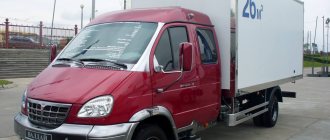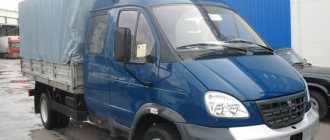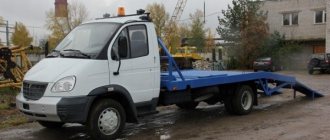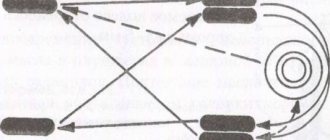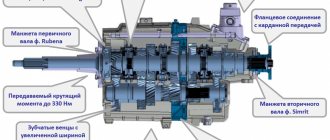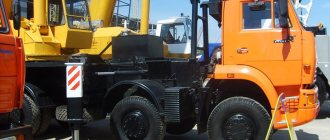The product of the domestic automotive industry, the low-loader Valdai truck, at one time replaced used foreign cars and filled the Russian market, which was in dire need of small and maneuverable middle-class trucks. The technology has found application in the transportation of goods of all types within populated areas, as well as outside the city. The car is distinguished by a well-thought-out design, original design, reliability and endurance on our far from perfect roads. Let's consider the carrying capacity of the GAZ-33106 Valdai and other characteristics.
Start of production
Maneuverability was not a big concern for Valdai’s predecessors, the medium-tonnage trucks of the GAZ-3307 family. Which, as you know, were developed back in the 80s of the twentieth century and were designed for operation mainly in rural areas. And in the cities then it was not at all as crowded as in our era.
The Valdai, unlike its predecessor, has a lower landing (the loading height of the loaded vehicle is only 985 mm). The reduction in loading height was also facilitated by the replacement of traditional GAZ 20-inch wheels with 17.5-inch wheels familiar to European delivery trucks.
Of course, in terms of cross-country ability, the Valdai cannot compete with the GAZ-3307. This is primarily a “city dweller”, a delivery truck of class N-2, MCV category, for paved roads. Unlike the Gazelle, a category B license to drive a Valdai will not be enough: it requires a category C license.
The first samples of the Valdai truck were created in collaboration with the Minsk Automobile Plant back in 1999. However, in the end, MAZ was ahead of the Nizhny Novgorod residents, being the first to launch its low-frame, medium-tonnage vehicle, the five-ton MAZ 4370 Zubrenok, into mass serial production.
There was an idea to equip a GAZ medium-duty truck with a cabless cab of the MAZ-5336 type, but it did not receive a concrete implementation. It was decided to use the mass-produced cabin of the Nizhny Novgorod superbestseller, the Gazelle.
Moreover, under the hood of the engine compartment of this cabin, which, as is known, is designed for a short 4-cylinder engine, it turned out to be quite compact to place the in-line 6-cylinder diesel engine "GAZ-562" (licensed "Steyr", the first engine " Valdai"). This made it possible, despite the engine cover sliding forward, to maintain space for a second passenger in the middle. That is, the cabin can be described as a “conditionally three-seater” for short trips and a two-seater for long and long-distance trips.
Externally, the GAZ-33106 Valdai is very similar to the Gazelle, but at the same time, it is noticeably different from it with its massive bumper and radiator grille, as well as more impressive dimensions. With a similar cabin and external similarity, the Valdai looks much more serious: its width and height are greater than those of the Gazelle by 284 and 125 mm, respectively.
The body structure of this truck is frame. The frame itself is assembled from side members taken from the GAZ-3307 model, with original traverses and brackets. Built on a five-ton platform, the Valdai has a significant margin of safety, allowing it to transport cargo weighing more than four tons. As a result of the evolution of the model, the GAZ-33106 was obtained - a modern business delivery vehicle with a convenient loading height, a fairly comfortable suspension, a safe braking system and an economical diesel engine. A car that can make you good money!
At the seventh International Specialized Exhibition “Commercial Vehicles”, held in 2006 in Moscow, the then new model of Gorky’s car was recognized as the winner in the “Best Domestic Truck” category.
The transition from Minsk diesel engines to modern Chinese-assembled Cummins engines in 2010 made the Valdai much more comfortable and quiet, unnecessary vibrations at idle went away and fuel consumption decreased. Supporters of this model have increased significantly. In this regard, the cessation of its production was received sharply negatively by many.
The last Valdai car rolled off the assembly line of the Gorky Automobile Plant in late December 2015. To replace the Valdai, the company introduced to the market the five-ton GAZon Next truck, a modification of the City - also with a low loading height, on low-profile wheels, an urban delivery truck.
However, opinions are still expressed about the unequal value of this replacement. Compared to the Valdai Gazelle, which has small dimensions and maneuverability, the GAZon Next is called a clumsy, “elephant-like” car and, moreover, an order of magnitude more expensive. It is also noted that GAZon Next is a still “raw” and unfinished model. Such sentiments affect demand: the market accepted GAZon Next with caution, and its sales in the first years of production did not shine.
Add-on options:
Manufactured goods van• Dimensions of the superstructure (LxWxH), mm: - external: 4700x2300x2400, - internal: 4630x2240x2290 • EPPS sandwich 30 mm, plywood 18 mm | Isothermal van• Dimensions of the superstructure (LxWxH), mm: - external: 4700x2300x2200, - internal: 4300x2140x2030 • EPPS sandwich 80 mm, plywood 18 mm | Eurovan• Dimensions of the superstructure (LxWxH), mm: - external: 4700x2300x2400, - internal: 4620x2200x2250 • Sliding roof and curtains, side 400 mm |
Dump truck• Dimensions of the superstructure (LxWxH), mm: - external: 4600x2200x620 (950) - internal: 4500x2100x475 (950) • Platform volume: 4.9 cubic meters (9.8) | Board with CMU | Tow truck |
- Characteristics
- Engine
- Options
- Similar models
- Reviews
Valdai dump truck
This unit is assembled in the city of Saransk, at the dump truck plant. There they install body equipment on a Valdai chassis, marked GAZ-33106. Designed at the automobile plant in Gorky, it belongs to the modernized Valdai family.
Like any dump truck, this machine can move and unload bulk cargo. These are, for example, building materials such as crushed stone, gravel, sand, expanded clay. It is possible to fill the body with snow, garbage waste, and coal. Such dump trucks are indispensable in the arsenal of farmers or utility workers - they help sprinkle sand on slippery pavements in winter, remove autumn leaves, snow and debris.
The car is also in demand among farms. Its comfortable cabin is the same as that of the Gazelle, and much more cargo can be placed in the body.
By the way, the manufacturers took special care of farmers by designing a modification that was called “Farmer”. Its difference is the enlarged cabin, which can accommodate not three, but five people. You can transport a whole team of workers comfortably.
Peculiarities
The chassis for the unit began to be made in 2010. Instead of the Belarusian one (previously used), they installed a new American diesel engine from the well-known company Cummins. The appetites of this engine are very modest, so one tenth less fuel was used. And it has a solid resource - half a million kilometers without major repairs.
However, this is not all the design features of the improved chassis that replaced the GAZ-33104. Its frame became stronger and more reliable, a new gearbox, spring suspension with stabilizers, and clutch were installed. The springs have lengthened. The hydraulic steering system has a new pump, and the disc brakes have a pneumatic control system. The ride became softer, the car made less noise, and shaking when driving was reduced.
Let us also note the ability of the dump truck wheels to make a forty-five-degree turn. It is this feature that makes it possible to maneuver so deftly in cramped city streets and turn around on narrow roads.
Advantages and disadvantages
Positive traits:
- The vehicle sits low and the turning radius is small. This allows the driver to easily work in the city.
- An economical, smooth-running and long-living diesel engine, adjusted to the conditions of our country (it has a spiral for heating the air in winter).
- A fairly comfortable cabin that can accommodate three people. Available in a modification with a five-seater cabin.
- Rear mirrors, which are mounted on brackets spread to the sides, provide excellent visibility.
- Conveniently located control devices, increased protection from noise and shaking.
- Not very high loading height (a little more than a meter). This allows you to use an electric car for loading.
- The fuel filter is located in a convenient location - behind the cab. Replacing it takes a couple of minutes.
- The three-piece bumper is easy to repair.
- The presence of a Cruise control system that turns on when the speed reaches 48 km/h.
Negative qualities:
- When the car is not loaded, the rigidity of the spring-type suspension affects it.
- The gas pedal is electronic and is not cheap to maintain.
- In extreme heat, the diesel engine begins to heat up, losing power. Craftsmen “cure” this by installing additional fans.
- Over time, the rear axle and gearbox seals begin to leak.
- The design features of the front suspension can cause vibrations of the wheels located in front. This happens until the machine comes to a complete stop.
Photo of the GAZ-33106 dump truck at the Valdai base
4.1. Total information
| Automobile model | GAZ-33106 | GAZ-331061 | GAZ-331063 |
| Vehicle type | Two-axle, cargo, with rear wheel drive | ||
| Loading capacity of the vehicle (with a platform without an extension side, awning arches), kg, | 3925 | 3640 | 3480 |
| Gross vehicle weight, kg | 7400 | 7400 | 7400 |
| Weight of the vehicle in running order (with driver, without extension, arches, awning), kg | 3325 | 3610 | 3545 |
| Overall dimensions, mm: | |||
| - length | 6050 | 7565 | 6770 |
| — width (by mirrors) | 2643 | 2643 | 2643 |
| — height (in the cabin without load) | 2260 | 2260 | 2265 |
| — height (on the awning without load) | 3060 | 3060 | 3060 |
| Base, mm | 3310 | 4000 | 4000 |
| Front wheel track, mm | 1740 | 1740 | 1740 |
| Rear wheel track, mm (between the centers of the double slopes) | 1702 | 1702 | 1702 |
| Vehicle ground clearance with full load, mm | 177 | 177 | 177 |
| Minimum turning radius of the vehicle along the track axis of the front outer wheel, m, no more | 6,8 | 7,7 | 7,7 |
| Maximum speed of a vehicle with a full load, without an awning, without a trailer, on horizontal sections of a flat highway, km/h | 105 | 105 | 105 |
| Fuel consumption1 when driving at constant speed, l/100 km: | |||
| — 60 km/h | 12,0 | 12,0 | 12,0 |
| — 80 km/h | 15,0 | 15,0 | 15,0 |
| Overhang angles (with full load),° | |||
| -front | 27 | 27 | 27 |
| -rear | 14 | 10 | 14 |
| Maximum angle of incline overcome by a vehicle with full load, % (°) | 25 (14) | 25 (14) | 25 (14) |
| Loading height of the platform, mm | 1070 | 1070 | 1070 |
* — 1 The given fuel consumption is not a standard, but serves only to determine the technical condition of the car.
Appearance
As mentioned above, Valdai (GAZ-3310) received new block headlights, made in the shape of a drop. They are complemented by a modified radiator grille. The powerful bumper is painted black. In front, in the center, below the radiator grille, there is a gray insert installed on it. The engine compartment, hood, and mudguards are covered with a layer of sound insulation.
The cabin can be in two versions. In the first case, it accommodates a driver and two passengers. But such capacity is conditional. There is not enough space for two passengers. Therefore, the three of us can only travel short distances. For long trips, the cabin can only accommodate one passenger. The second version involves a double cabin that seats 6 people.
GAZ-3310 "Valdai": technical characteristics
The Valdai car was developed on the basis of a chassis from a five-ton GAZ-4301 truck. But it has undergone significant changes. The installed front axle can withstand heavy loads. A stabilizer bar is installed on the rear axle.
The suspension is made of high quality, which ensures smooth movement. Thus, the front suspension is represented by leaf springs on silent blocks. Hydraulic telescopic shock absorbers are installed on all sides. The rear has a progressive spring without a suspension.
Valdai is the first domestic car with a pneumatic braking system. Prior to this, pneumatics were used only on prototypes. Due to this, the system does not require additional brake fluid. Ventilated disc brakes are installed both front and rear. But that's not all! To improve braking properties and improve active safety, the car is equipped with an anti-lock braking system.
The steering mechanism is supplemented with a hydraulic booster. This makes driving much easier. In addition, due to this, the wheels can rotate at an angle of 45 degrees.
Scope of application of the truck
Its main application is the transportation of various cargoes, small and oversized, with a total weight of no more than four tons. It is also possible to install various special equipment on the vehicle platform: tilt, manufactured goods vans, refrigerators, crane-manipulators, and flatbed bodies of various sizes.
The GAZ-33106 tow truck has become widely used, as well as vehicles equipped for transporting bakery products, as they have excellent maneuverability and small overall dimensions. This greatly facilitates movement in urban environments.
Based on the above, we can confidently note that the domestic GAZ-33106 truck is rightfully a universal medium-duty vehicle with a wide range of applications. Moreover, both in terms of equipment and in terms of terrain features.
Components of the GAZ-33106 Valdai model
The GAZ Valdai gearbox is a five-speed unit with the addition of synchronizers. The main gear is hypoid, conical type. The cardan transmission used is represented by a two-shaft unit with an intermediate support, as well as three cardan joints in a system of needle bearings.
The vehicles are equipped with a single-plate clutch with a pre-installed hydraulic drive. Updating the car line during the transition to the use of Cummins engines also concerns the car's transmission. The previously used gearbox has been redesigned, thereby increasing the reliability of the components. Imported components were installed at the base of the diaphragm clutch. The steering is represented by a screw-ball nut with an effective gear ratio of 19.8. An integral hydraulic power steering has been introduced, which has been added to the existing steering mechanism.
The car's standard factory equipment includes cruise control, and some modifications include a special two-row cab with an installed coolant heater. Valdai cars are equipped with a dual-circuit braking system with a pneumatic drive. Disc brakes are equipped with special sensors that determine the degree of physical wear of the pads.
The service life of the pads is calculated at a total of 200 thousand km. Telescopic, hydraulic shock absorbers with double-sided functioning are installed. The dimensions of radial, pneumatic tires are 215/75R17.5. The rated voltage level in the current electrical network is at 12V. A powerful current generator has been added, as well as a pair of batteries. The engine control system is represented by a microprocessor device that provides control over the fuel supply.
Transmission
The GAZ-33106 transmission includes a single-disc clutch (diaphragm) “Sacs”. It has many advantages over other types of these devices that the concern equips other truck models with.
This is not only a fairly large resource, but also excellent build quality and individual parts. The Valdai is equipped with a five-speed gearbox. The range of gear ratios is from 6.5 to 1.
There is also a power take-off shaft. The gearbox housing is made of aluminum. Its design contains stiffening ribs, they allow you not to worry about the safety of the gearbox even on problematic Russian roads.
High strength is achieved due to the fact that the box connector is made in a vertical plane.
GAZ 3310 – car review
GAZ 3310 Valday / GAZ 3310 Valday
GAZ 3310 Valdai is a Russian-made medium-duty commercial vehicle. Production of the model started in 2004 at the Gorky Automobile Plant. The idea of developing the Valdai car dates back to the late 1990s, when the GAZ company became concerned with creating a medium-duty car that was in demand on the Russian market. The development of the model was initially carried out jointly with the Minsk Automobile Plant, but a little later MAZ refused to participate in the project. Valdai received a modernized chassis from the GAZ 4301 model. For the GAZ 3310 Valdai, the suspension was developed “from scratch”, and new front and rear axles were introduced. The braking system was pneumatic and equipped with an ABS system. “Fresh” design solutions made it possible to create a modern, reliable and practical car for the Russian market - GAZ 3310 Valdai.
GAZ 3310 Valdai exists in various modifications. There is a version with a classic, 3-seater or double, 6-seater cabin. GAZ 3310 Valdai is offered with a powerful 3.8 liter turbodiesel. The Cummins ISF 3.8 diesel engine is equipped with a modern Common Rail fuel supply system. The resource of Valdai is 500 thousand km.
Let's sum it up
If we compare the Valdai GAZ 3310 model with a simple GAZelle, the model has become much better. Its load capacity has been increased, improved technical characteristics have appeared, a suspension that improves the quality and level of control, which provides a good smooth ride.
In the end, they began to use a pneumatic brake system, which is much better than a hydraulic one in terms of cost and maintainability. In addition, well-known American power units from Cummins began to be installed on new vehicles, which had a positive effect on fuel consumption; it was reduced by 1 liter.
Photo of a GAZ-3310 car
The engine also became a little quieter and efficiency increased. It is clear that externally and internally the Valdai is very similar to the old GAZelle, but this is where the similarities almost end. A truck from the Gorky Automobile Plant can be ordered for any small and medium-sized business, and it will serve well.
The truck is even equipped with an ABS system, which, together with ventilated disc brakes, provides productive braking. Even in terms of cost, the GAZ-3310 is the leader on the Russian market, which is why it can be seen so often on the roads of many countries. Reviews of GAZ Valdai on the Internet are very good.
We advise you to read the article: GAZ - the history of car production.
Exterior and interior
If we talk about the cabin of the GAZ-3310 Valdai truck, it is represented by the “Gazelle” version, but it was still slightly changed. For example, we used plastic fender flares and updated the radiator trim. The bumper now consists of 3 parts, the middle of which has a metal material. As well as externally, inside the GAZ 3310 Valdai is completely identical to the simplest and most common GAZelle.
The driver's seat is separated from the passengers' seat. The front panel was made of not very high quality plastic. The steering wheel has a thin rim and a pair of spokes. Immediately behind it are the control lever for the direction indicators (on the left) and the sound signal, as well as the control lever for the wipers (on the right).
Photo GAZ-Valdai
There are two large round gauges on the dashboard, where the left one is the speedometer and the right one is the tachometer. In the far left corner there is a fuel level sensor, and in the right there is a sensor that shows the engine temperature. A little lower, under them, on the sides there are air pressure sensors.
The ignition switch is installed on the left side of the steering wheel. The middle of the front panel has compartments for installing music players. In front of the windshield, on the sides, the already familiar music system speakers were installed.
Salon GAZ-Valdai
The location of the deflectors is quite standard, which allows you to maintain the required temperature in the cabin. All controls are quite clear. On the right there is a small glove compartment for storing the necessary small things. The seats received headrests, which made travel more comfortable.
Overall, the cabin is quite spacious, with plenty of headroom. In addition to pressure gauges, they added an electronic gas pedal, which drivers did not like much, because it is very expensive to maintain, and its advantages are rather dubious.
4.9. Basic data for adjustments and control
| Gaps between valve stems and rocker arms on a cold engine, mm: | |
| - intake | 0,330 |
| — graduations | 0,584 |
| Oil pressure (at oil temperature 80–85° C), kPa (kgf/cm2): | |
| -at a rated crankshaft speed of 2600 min1 (minimum permissible) | 207 (2,07) |
| -at minimum idle speed (minimum permissible) | 69 (0,69) |
| Optimal fluid temperature in the engine cooling system, °C | 80–95 |
| Minimum crankshaft rotation speed at idle speed, min-1 | 750+50 |
| Adjustable voltage, V | 13,3–14,9 |
| Clutch pedal free play, mm | 10–30 |
| Full travel of the clutch pedal, mm | 190 |
| Free travel of brake pedal, mm | 9–16 |
| Total steering wheel play, ° | According to GOST R51709–2001 |
| Tire air pressure, kPa (kgf/cm2): | |
| - front wheels | 530+10 (5.4+(M) |
| - rear wheels | 620+10 (6,3+01) |
Cabin of the GAZ-33104 Valdai car
The cabin of the Valdai vehicles is maximally unified with the Gazelevskaya. You could even say that they are identical. Minor changes were made to the bumper and radiator grille. The bumper is more massive and consists of three parts. Another point: the cabin now has steps, since it is noticeably higher than the Gazelevskaya. The mirrors are increased in size, mounted on different brackets and equipped with electric heating.
The interior and level of comfort in the Valdai cabin are almost the same as in the Gazelle. The workplace can be adjusted to suit a person of almost any build and height: the steering column moves both in height and in angle of inclination. And the driver's seat varies in height. When traveling short and medium distances, the comfort in the cabin is quite sufficient. It’s not enough for a long-range driver: a sprung seat wouldn’t hurt.
Chassis
The truck frame elements are made of high-strength steel by stamping and riveting, which results in high load capacity and endurance.
Spars with variable profile sizes are the main component of the frame, which is used as the basis in all models of this car brand, regardless of equipment. To increase the overall dimensions, it is possible to use special frame inserts in the side members, which are fastened with rivets. Thus, it is possible to change the length of the frame for a certain type of platform.
Such work can be carried out both in the factory and at companies that specialize in re-equipping cars of this brand.
GAZ-33106 is equipped with stamped steel wheels, rim size 6/17.5 mm, and 216/75 tires with a diameter of 17.5′, which is very convenient in terms of operation and interchangeability.
Device
Body
To raise or lower the metal body, a hydraulic system is used, which can be controlled from the driver’s seat. The telescopic hydraulic cylinder consists of five sections. It is possible to unload bulk substances backwards, left and right. To do this, you need to manually fold back the sides. The desired direction of body tilt is set using locking pins. When the car is moving, the body is locked with a special device that has a direct connection with the hydraulic locking valve.
Engine
Cummins diesel, although American, is produced at a company plant in China. It has four in-line cylinders and is turbocharged (using a HE211W compressor). Hot air is cooled by liquid cooling.
A Common Rail fuel supply system with an electromagnetic pressure regulator and a radial pump is used. Ignition is carried out using a microprocessor circuit that controls the starter.
Transmission and chassis
The synchronized manual transmission, assembled in the rear and front crankcases, has five stages. Accordingly, when moving forward, one gear out of five is selected, but when moving backwards there is no choice - only one speed. Synchronizers work with all gears except first and reverse. The main gear is screw, single type, with gear bevel wheels.
A dry clutch with a single disc, which is permanently closed, is equipped with a diaphragm-type spring and a damping mechanism located on the driven disc. Its hydraulic drive is controlled by an overhead pedal that engages the main hydraulic cylinder. It is located in the front part of the cabin, on the dashboard.
The front and rear suspensions are dependent; they are equipped with spring mechanisms and stabilizers that provide stability in the transverse direction. The longitudinal springs of the rear axle are multi-leaf, and the front axle are multi-leaf. The springs are attached to the frame by hinges. Telescopic hydraulic devices are used for shock absorption.
Valdai dump truck diagram
Brakes
The working brake system consists of two circuits (one for each axis). Disc-type braking mechanisms are operated by a pneumatic drive. There is an anti-locking device for ABS type brakes from. The parking braking system is activated by a hand lever and acts on the axle of the rear wheels. Pneumatic cylinders equipped with spring-type accumulators are used.
Steering
The steering shaft, equipped with a compensator, has a hinged design. The steering wheel is adjusted using a special device. The steering control mechanism is a ball nut and screw connection. To make it easier to turn the wheels, a hydraulic power steering system with a vane pump is built in.
Cabin
As already mentioned, the dump truck received its cab from the Gazelle. It is equipped with comfortable footrests, has a semi-hood type, and is made entirely of metal. There is an additional plastic coating against corrosion.
The standard cabin seats three, but there are some variations: with a berth, as well as a two-row cabin (for five people). Heating and ventilation systems have been installed.
Electrics
The voltage on board the dump truck is 12 volts. “Minus” traditionally goes to the body. There are two 6ST-110 type batteries, as well as a generator with a rectifier unit and a regulator. Power is supplied to the starter, microprocessor diesel control system, headlights, rear and front lights, control devices and sound alarms, windshield wipers, ventilation and heating.
4.2. Engine and its systems
| Engine model | ISF3.8s3154 |
| Type | Diesel, 4-stroke, turbocharged, charge air cooled, liquid cooled |
| Number and arrangement of cylinders | 4, vertical in a row |
| Cylinder operating order | 1–3–4–2 |
| Crankshaft rotation direction | Right |
| Cylinder diameter and piston stroke, mm | 102×115 |
| Working volume, l | 3,76 |
| Compression ratio | 17,2 |
| Rated net power, kW (hp), not less than: | |
| — at a crankshaft speed of 2600 min -1 | 112 (152.3) |
| Maximum net torque, N-m (kgf-m): | |
| — at a crankshaft speed of 1200–1900 min -1 | 491 (50.1) |
| Minimum stable idle speed, min -1 | 800 |
| Maximum idle speed limited by regulator, min -1, no more | 2950 |
| Ventilation system | Open |
| High pressure fuel pump | With Common Rail fuel equipment (Bosch) CR/CP 3S3L110–30–789S Radial, 3-piston, with electromagnetic pressure regulator, with mechanical booster pump |
| Fuel lift pump | Mechanical - as part of the injection pump Manual - in the fuel coarse filter housing |
| High pressure fuel accumulator | Cylindrical, with pressure relief valve |
| Injectors | 0445 (Bosch) with solenoid control valve |
| Fuel filters: | |
| — pre-cleaning | Pre-cleaner, with a manual fuel priming pump and a water separator, with a replaceable filter element, a sensor for the presence of water in the fuel and an electric fuel heater |
| — fine cleaning | With replaceable filter element |
| Lubrication system | Combined: pressure and spray |
| Oil radiator | Full-threaded, always on |
| Oil filter | Full flow, with replaceable filter element |
| cooling system | Liquid, closed, with forced circulation of coolant, with expansion tank |
| Pressurization system | Gas turbine, with one HE211W turbocharger with a radial centripetal turbine, a centrifugal compressor and a tube-plate type charge air cooler |
History of creation
GAZ-33104B with semi-trailer
After the collapse of the cartel with AMO ZIL in the late 1990s, the Gorky Automobile Plant became concerned with creating a market-demanding low-frame, medium-duty delivery vehicle for transportation on roads of improved categories. The first samples were created jointly with the Minsk Automobile Plant, but later the Minsk residents unilaterally refused to supply their MAZ-5336 type cabs to GAZ and launched a family of 5-ton low-loader trucks MAZ-4370 “Zubrenok”. GAZ had to independently develop a cabin for the existing chassis. The power base of the mass cabin of the popular GAZelle (GAZ-3302) was used for it. Under the hood of the engine compartment, designed for a short four-cylinder engine, it was possible to quite compactly place the in-line six-cylinder diesel GAZ-562 (Steyr license). This made it possible, despite the protruding engine casing, to maintain space for a second passenger, that is, the cabin is listed as “conditionally three-seater” for short trips and two-seater for long-distance trips. The modern design of the tail of the new truck, which received the industry index GAZ-3310, was achieved through the use of modern segmented drop-shaped headlights, a reshaped hood and radiator grille, as well as a powerful integral bumper. A prototype of the 4-ton GAZ-3310 truck, named "Valdai", was shown at the 1999 International Moscow Motor Show. The road to the Valdai conveyor was opened by the development in 2003 of mass production of block headlights used for restyling of the GAZelle and Sobol families of commercial vehicles. For the Valdai, the chassis of the GAZ-4301 type (5-ton diesel truck) was modified, the front suspension was completely changed, new front and rear axles were introduced, and low-profile wheels were used. The braking system was made only pneumatic and modified to include the installation of ABS (with the prospect of using the Valdai chassis for buses). The entire set of design solutions made it possible to create a modern truck with a low loading height (1000 mm), a fairly comfortable suspension, a safe braking system and an economical diesel engine. Diesels MMZ D-245.7, GAZ(Steyr)-562, Cummins 3.9 140 CIV, IVECO-8143, SOFIM were offered as a power unit for Valdai. For economic reasons, preference was given to the Minsk D-245.7 (122 hp) - a modification of the GAZ-33104. In 2006, production of the GAZ-331041 version, extended in wheelbase to 4 m, began. At MIMS-2005, an experimental modification of the GAZ-43483 was shown with a reinforced chassis with a total weight of 8.5 tons and a double cabin, intended for intercity transportation as part of a road train, and also as a chassis for promising models of small-class buses. On the basis of Valdai in 2004-2006, experimental Russian small-class buses KAvZ-32081 and PAZ-3202 were created. In Ukraine, the small GalAZ-3207 bus and Kasatka fire trucks are mass-produced on the Valdai chassis. In November 2010, GAZ announced the start of production of a 4-ton version of the GAZ-33106 with a Cummins ISF 3.8 engine. In the last days of December 2015, the last Valdai truck rolled off the assembly line of the Gorky Automobile Plant. It was replaced by a new urban 5-ton delivery truck, GAZon NEXT City, with low-profile wheels and a reduced loading height, the production of which began in mid-2015.
General information
Despite the fact that neither large nor medium-sized businesses buy the car with great excitement, more than 23,000 copies were sold. This indicator is an unattainable result for classmates of foreign models. It is worth adding that the car has only been produced for about 9 years, and many cars bought at reduced prices in other countries were not included in the statistics.
Such an intricate prevalence can be explained quite easily - from a distance the car looks like a GAZelle, which is not striking. And the GAZ-3310 is most often purchased by small carriers that have outgrown the GAZelle with 1.5 tons of cargo. However, so far there are only a few such vehicles, and the GAZelle exceeds the number of Valdai by 50 times.
GAZ-Valdai
In addition, if we recall that the “lorry” was produced in approximately four million units (GAZ-53), then the GAZ-3310 is not that it is not a leader, it is rather an outsider. Although this is quite different, because modern medium-duty vehicle logistics plays a much smaller role than during the era of the Union of Soviet Socialist Republics, which was an early agricultural power.
Today, cargo delivery is managed by massive long-haul trucks along with frameless light-duty vans. But already in the small area of medium-duty vehicles, the favorite is the GAZ-3310. Moreover, it has not yet exhausted its market potential, since the difference in cost with the GAZelle on diesel fuel does not cross the border of 20%.
GAZ-Valdai truck
The debut samples were designed together with the Minsk Automobile Plant, but in the future Minsk specialists decided to unilaterally refuse to sell their own cabins, such as the MAZ-5336, to the Gorky Automobile Plant. They decided to launch a whole generation of 5-ton low-bed trucks MAZ-4370 “Zubrenok”.
Therefore, Gorky workers had no choice but to independently develop a cabin for an existing chassis. We decided to use the power base of the mass cabin of the famous GAZelle. When the car was being prepared for mass production, they mastered the production of 1,295 unique spare parts.
Side view of GAZ-Valdai
To achieve this, 6,747 equipment positions were manufactured, which included 207 massive and medium dies, 62 forging dies, 40 welded constructors, 14 plastic molds and 547 working fixtures. In the shortest possible time, using the latest methods of mathematical modeling, FutoForm, together with computer-aided design, developed the processes and designs of 67 large, 117 medium and 246 small dies for 207 unique stamped elements. An experimental model of the 4-ton truck 3310, which was called “Valdai”, was shown at the International Moscow Automobile Salon in 1999.
GAZ-3310 Valdai can be easily confused with a regular GAZelle, because they have a lot in common both outside and inside.
The current design of the new car, which received the name GAZ-3310, was obtained through the introduction of current segmented headlights with a teardrop shape, a hood, a radiator grille whose shape has been changed, and a massive integral bumper. The hood, along with the mudguards and power compartment panel, received a noise insulation coating.
In general, the conveyor path of the GAZ-3310 was indicated by the use of serial production of block headlights since 2003, which were used for updated generations of commercial vehicles of the Gorky Automobile Plant, which includes the Sobol. The car has a number of its own advantages, including a small turning radius (6.4 m).
GAZ-Valdai car
Thanks to its low height (from 985 mm), it is possible to load heavy items quite comfortably. The Valdai division is a reliable business car that quickly pays for itself with good efficiency and maintainability. Various vans are provided for Valdai.
For example, there is an isothermal van on the GAZ-33106 platform. It was created for transporting goods that are critical to changes in temperature. Thanks to the special material of the van, it is possible to maintain the required temperature, which protects the products from the influence of the external environment.
Photo of a GAZ-Valdai truck
A couple of body types are used: polymer and sandwich panels. The latter have metal sheets of outer skin, between which liquid polyurethane foam is poured. Once it sets, it begins to harden, which serves as excellent insulation.
After all this, glue is poured. This type of van is perfect for installing a refrigeration unit. There is a modification of GAZ 33104 Valdai and GAZ 33106 Valdai. This common car will be discussed in this article.


